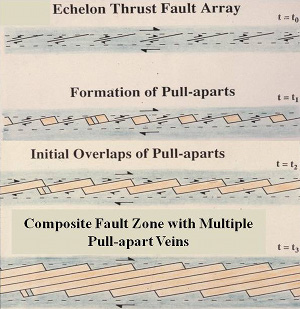| |||||||
|
|
|||||||
|
|
|||||||
| Mechanisms and Mechanics of Composite Faults | |||||||
|
We have described composite faults formed by two different mechanisms although other mechanisms may undoubtedly exist. One of these owes its existence to ductile deformation of shales and will be dealt with under 'Faulting by Shale Smearing.' The second may be idealized as follows: A series of faults are localized within a shear zone very much like a Riedel shear (Figure 1). The neighboring fault segments with a thrust sense of shearing interact forming pull-apart veins. As the pull-apart veins lengthen, they overlap forming multiple veins bounded by the overlapping fault segments. The geometry may vary depending on the section available for view. The most informative section includes the slip direction and is perpendicular to the fault zone. | |||||||
| Reference: |
|||||||
| Ohlmacher, G., Aydin, A., 1995 |
|||||||
|
Readme | About Us | Acknowledgement | How to Cite | Terms of Use | Ⓒ Rock Fracture Knowledgebase |
|||||||
